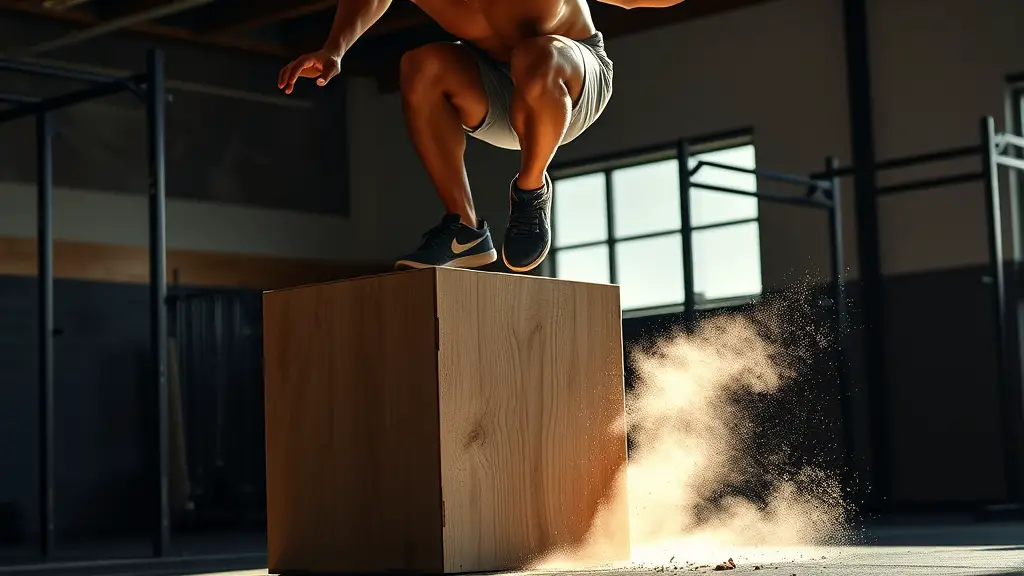The Best Plyometric Drills for Strength Athletes

To maximize your explosive power as a strength athlete, focus on key plyometric drills like jump squats, box jumps, and burpees. These exercises build strength and enhance agility. Incorporate plyometric push-ups for upper body power and tuck jumps for speed. Don’t forget depth jumps to boost your reactive strength. Aim for 1-3 sessions per week, progressively increasing intensity. By integrating these drills, you’ll see significant improvements in performance and agility, and there’s more to explore to optimize your training.
Understanding Plyometrics and Their Benefits

Plyometrics, often celebrated for their explosive power and agility benefits, play an essential role in enhancing athletic performance. To truly harness their potential, you need to understand the plyometric fundamentals. This training method focuses on rapid stretching and contracting of muscles, which allows you to develop strength and speed simultaneously.
Incorporating explosive training into your routine can greatly improve your overall athletic ability. By engaging in exercises that emphasize maximal force production, you’re not just building muscle; you’re also enhancing your neuromuscular coordination. This leads to better reaction times and increased power output during your primary sport activities.
Starting with basic plyometric drills like box jumps or burpees can help you grasp the mechanics involved. As you progress, you can integrate more advanced movements that challenge your strength and explosiveness. Embracing these fundamentals will lay a solid foundation for achieving your athletic goals.
Jump Squats: Building Explosive Power
Jump squats are a highly effective exercise for building explosive power, which is vital for athletes looking to enhance their performance. By incorporating jump squats into your training regimen, you’ll engage fast-twitch muscle fibers, leading to improved strength and speed. Start with the basic jump squat, ensuring you maintain proper form: feet shoulder-width apart, lower into a squat, then explode upward.
To maximize your training, consider jump squat variations such as weighted jump squats or single-leg jump squats. These variations not only challenge your stability but also intensify the explosive power benefits. Aim for three sets of 8-12 repetitions, focusing on both height and control. Remember, proper landing mechanics are essential to prevent injury, so land softly and reset to the squat position before each rep. By consistently incorporating jump squats and their variations, you’ll see significant gains in your athletic performance.
Box Jumps: Enhancing Vertical Leap

Building on the foundation of explosive power established by jump squats, box jumps serve as an excellent tool for enhancing your vertical leap. To maximize their effectiveness, consider these key points:
- Optimal Box Height: Choose a box height that challenges you without compromising form. Start low and progress as you gain confidence.
- Box Jump Variations: Incorporate different variations such as step-ups, lateral jumps, or depth jumps. This variety targets different muscle groups and keeps your workouts engaging.
- Technique Focus: Guarantee proper landing mechanics by focusing on a soft, controlled descent. This minimizes injury risk and improves your overall jumping efficiency.
Burpees: Combining Strength and Agility
Burpees pack a powerful punch by blending strength and agility into one dynamic movement. They engage multiple muscle groups, making them an efficient choice for strength athletes. You can mix up your routine with various burpee variations to keep things fresh and challenging.
| Burpee Variation | Key Benefit | Recommended Reps |
|---|---|---|
| Standard Burpee | Full-body conditioning | 10-15 |
| Tuck Jump Burpee | Explosive power | 8-12 |
| Push-Up Burpee | Upper body strength | 6-10 |
Incorporating burpees into your training can improve cardiovascular endurance while enhancing muscle coordination. The burpee benefits extend beyond physical strength; they also promote stamina and agility. So, whether you’re looking to build muscle or boost your performance, burpees are a versatile tool in your arsenal.
Plyometric Push-Ups: Developing Upper Body Power

While strength athletes often focus on traditional push-ups for upper body conditioning, incorporating plyometric push-ups can markedly enhance explosive power. This plyometric variation not only boosts upper body strength but also engages fast-twitch muscle fibers essential for athletic performance. Here’s how to effectively integrate plyometric push-ups into your routine:
- Start Position: Begin in a standard push-up position, maintaining a tight core and straight body line.
- Explosive Movement: Lower yourself slowly, then push up explosively, aiming to lift your hands off the ground.
- Landing Technique: Land softly on your hands, absorbing the impact by bending your elbows slightly.
Lateral Bounds: Improving Side-to-Side Movement
Lateral bounds are a powerful exercise for enhancing side-to-side movement and agility, essential for many sports and athletic activities. By incorporating this plyometric drill into your agility training, you’ll develop explosive lateral strength, which can greatly improve your performance.
To perform lateral bounds, start in a standing position with your feet shoulder-width apart. Push off one leg, driving your knee upward while jumping laterally. Land softly on the opposite leg, maintaining balance and control. Focus on using your hips and core to stabilize your landing and immediately jump back to the starting position.
Aim for height and distance with each bound, ensuring that you engage your muscles properly. Incorporating lateral bounds into your routine will not only enhance your lateral movement but also reduce the risk of injury by strengthening the muscles involved in side-to-side action. Aim for 3 sets of 10-15 bounds per side to maximize your agility training benefits.
Medicine Ball Slams: Engaging Full Body Strength

Building on the foundation of lateral bounds, incorporating medicine ball slams into your training regimen can greatly enhance your full body strength and power. This dynamic exercise not only targets multiple muscle groups but also promotes full body engagement, making it an effective choice for strength athletes.
To maximize the benefits of medicine ball techniques, follow these key points:
Maximize your medicine ball training by focusing on proper form, explosive execution, and safe recovery techniques.
- Form: Maintain a strong stance with feet shoulder-width apart. Engage your core throughout the movement.
- Execution: Lift the medicine ball overhead, then slam it down explosively, using your entire body to generate power.
- Recovery: Bend your knees to absorb the impact, ensuring your back remains straight to prevent injury.
Tuck Jumps: Increasing Speed and Coordination
Tuck jumps are an excellent plyometric exercise that can enhance your speed and coordination, vital for strength athletes. By focusing on proper technique, you’ll maximize the benefits and reduce the risk of injury. Let’s explore the key advantages and the correct execution of tuck jumps to elevate your training.
Benefits of Tuck Jumps
Jumping exercises, like tuck jumps, offer considerable benefits for athletes aiming to enhance their speed and coordination. By incorporating tuck jumps into your plyometric training, you can experience the following advantages:
- Improved Explosiveness: Tuck jumps develop fast-twitch muscle fibers, essential for explosive movements in various sports.
- Enhanced Coordination: This exercise requires synchronizing your arms and legs, improving overall body coordination vital for athletic performance.
- Increased Core Stability: Tucking your knees to your chest engages your core, leading to better stability and balance during dynamic movements.
These tuck jump benefits contribute to a well-rounded training regimen, enabling you to perform better and reduce the risk of injury. Implementing tuck jumps into your routine can meaningfully elevate your athletic capabilities.
Technique for Success
When performing tuck jumps, proper technique is essential for maximizing speed and coordination. Start by standing with your feet shoulder-width apart and your knees slightly bent. As you jump, engage your core and swing your arms down for momentum. Drive your knees toward your chest while keeping your hips tucked. Landing softly is key; aim to absorb the impact by bending your knees and keeping your feet flat. For technique refinement, practice in front of a mirror or record yourself to identify areas for improvement. Incorporate success strategies like gradual increases in jump height and frequency to build confidence and skill. Consistent practice will enhance your performance, making tuck jumps an effective addition to your training regimen.
Depth Jumps: Maximizing Reactive Strength

When performing depth jumps, focusing on technique and form is essential to maximizing your reactive strength. Proper execution not only enhances your athletic performance but also reduces the risk of injury. Understanding the benefits these jumps offer can help you incorporate them effectively into your training regimen.
Technique and Form
To maximize reactive strength during depth jumps, it’s vital to focus on technique and form throughout the movement. Proper alignment and explosive technique are essential for achieving peak performance. Here are three key points to guarantee you’re executing depth jumps effectively:
- Foot Placement: Maintain shoulder-width stance, landing on the balls of your feet to absorb impact and prepare for the next explosive jump.
- Knee Alignment: Keep your knees aligned with your toes during landing to prevent injury and enhance stability.
- Core Engagement: Activate your core throughout the jump to maintain balance and control, allowing for a more powerful rebound.
Benefits for Athletes
Depth jumps offer significant benefits for athletes looking to enhance their reactive strength and overall performance. By incorporating depth jumps into your training routine, you can improve your ability to generate explosive power, essential for sports that require quick bursts of speed. These jumps promote muscle adaptation through the stretch-shortening cycle, optimizing your muscles’ efficiency during dynamic movements. Additionally, depth jumps can play an important role in injury prevention; they strengthen stabilizing muscles and improve neuromuscular control, reducing the risk of common injuries. As you progress with depth jumps, you’ll notice increased agility and responsiveness, allowing you to outperform competitors. Emphasizing these jumps in your training regimen is fundamental for achieving peak athletic performance while minimizing injury risk.
Incorporating Plyometrics Into Your Training Program
Incorporating plyometrics into your training program can significantly enhance your explosive strength and overall athletic performance. To effectively integrate these drills, consider the following key points:
- Start with Progressive Overload: Gradually increase the intensity and complexity of your plyometric exercises. This could mean adding height to jumps or increasing the volume over time to keep challenging your muscles.
- Adjust Training Frequency: Aim to incorporate plyometric workouts 1-3 times per week, depending on your overall training schedule. This allows adequate recovery while ensuring consistent stimulus to improve power.
- Blend with Strength Training: Combine plyometric drills with your existing strength routines. This synergistic approach maximizes gains, helping you develop both strength and explosiveness simultaneously.
Frequently Asked Questions
Can Beginners Safely Perform Plyometric Drills?
Imagine a young tree, enthusiastic to reach the sky but needing strong roots first. As a beginner, it’s essential you focus on modifications to build that foundation. Start with basic movements like step-ups or knee tucks, ensuring your form’s solid. Gradually introduce plyometrics while prioritizing injury prevention. Listening to your body is key; if something doesn’t feel right, it’s okay to adjust. With patience, you’ll grow strong and capable in your training journey.
How Often Should Plyometric Training Be Done Each Week?
When considering how often you should do plyometric training each week, frequency recommendations typically suggest 1 to 3 sessions. It’s essential to balance this with recovery considerations, as plyometrics can be demanding on your muscles and joints. Allow at least 48 hours between sessions to promote ideal recovery. Monitoring your body’s response to workouts will also help you determine the right frequency for your individual needs and goals.
Are There Any Risks Associated With Plyometric Exercises?
Yes, there are risks associated with plyometric exercises, primarily related to improper technique and overtraining. To mitigate these risks, focus on injury prevention through proper warm-ups and cool-downs. Incorporating exercise modifications can help tailor the intensity to your current fitness level. Pay attention to your body’s signals; if you experience pain or discomfort, adjust your routine accordingly. Prioritizing safety will enhance your training effectiveness and minimize the likelihood of injury.
What Equipment Is Needed for Plyometric Drills?
For effective plyometric drills, you’ll need minimal equipment to get started. A sturdy jump box is essential for various jumping exercises, allowing you to safely perform box jumps and depth jumps. Additionally, resistance bands can add versatility to your routine, helping you enhance strength and explosiveness. You can anchor them for resisted jumps or incorporate them into your movements for added resistance, maximizing the benefits of your plyometric training sessions.
How Do Plyometrics Complement Strength Training Programs?
Plyometrics complement strength training programs by enhancing explosive power and improving muscle recruitment. When you incorporate these drills, you train your muscles to exert maximum force in short bursts, which translates into better strength gains. This dynamic training method activates fast-twitch muscle fibers, promoting greater efficiency in your lifts. By integrating plyometric exercises, you’ll not only boost your overall athletic performance but also enhance your strength training outcomes considerably.





